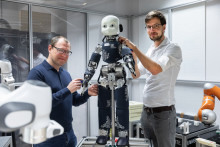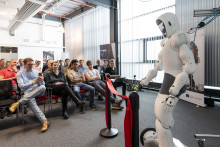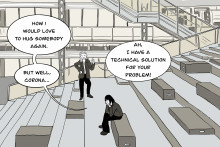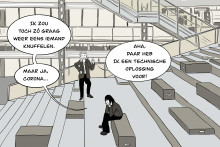‘PACOF is part of a larger line of research into creating first avatar systems,’ explains Dresscher. ‘We specifically focus on the manipulation of a robot as an extension of yourself. Mainly, we are looking into delay issues that inevitably occur. There is always a time delay between the operator’s command and the robot’s action, but this delay can have major consequences. We’d like to, on one hand, be able to model and predict what the operator wants to do and steer the robot towards it and, on the other hand, predict the response of the environment to provide the operator with accurate feedback.’
Avatar systems
If this issue is solved, it brings us one step closer to avatar systems, using robots wherever we cannot be and actually feel as if we are there. Such complex avatar systems are still under development, but there are robotic systems that are already in use. ‘They are rather limited, but they exist,’ says Dresscher. ‘For example, police uses a robot to disassemble or inspect bombs. This is possible, but they are not feeling as if they are the ones doing it, and it is operated at relatively short distances, which means the issue of time delay is very small.’
‘Avatar systems can take many forms in the future,’ continues Dresscher. ‘One example is healthcare applications, using robots to support patients at home. This could help us care for our loved ones over distance. For example, in Norway healthcare workers need to spend a lot of time travelling to patients’ homes because the country is sparsely populated and the distances are great. If we had avatars, they could support a lot more patients and save time travelling. Other possible applications are of course in industry, taking people out of dangerous situations and sending robots instead. But in the future you could even use avatars to simply visit places where you cannot or don’t want to travel.’

Predictions
Before any of that happens, many challenges need to be solved. The UT researchers are tackling two of them, explains Englebienne. ‘We will work on predicting what the operator needs and therefore what the robot should do and predicting how the environment will respond to provide meaningful feedback to the operator. And we will be dealing with the consequences of inaccurate predictions – because there will be mistakes in those. This should help us minimize the issues of time delays.’
‘There isn’t one single application that we are looking at,’ clarifies Schwenninger. ‘We want to create a unified framework that could be adjusted to specific uses. This is an enormous challenge also from the theoretical point of view. I’m sure that we can use this project’s findings for the larger scientific community, such as other applications in mathematical control theory,’ explains the researcher. Schwenninger will be the one focusing on the mathematical models, while Dresscher is working on the connection between the operator and the avatar, and Englebienne is studying the behaviour of the operator.
PACOF is not only about solving technical issues, though. ‘We are targeting the experience of the operator,’ clarifies Englebienne. ‘We will consider the project successful if we can show that our method has added value for the user.’








